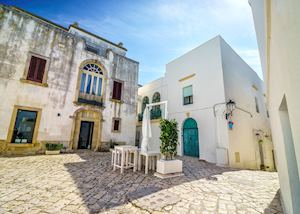Jump to:
Italy's most easterly port was once a seat of Byzantine power with traders, pilgrims and Crusaders thronging its whitewashed streets and busy waterfront. Today, Otranto is a popular summer destination with a labyrinth of lanes leading away from the water, an impressive castle and a cathedral with vivid 12th-century floor mosaics.
With its pavement cafés and gelaterias, easy-going atmosphere and strolling visitors, Otranto is a pleasant destination, further enhanced by the surrounding crystal-clear waters. On a fine day you get far-reaching views across the Adriatic to Albania.
The oldest part of Otranto is the walled medieval quarter that provides sweeping views of the sea. Its narrow, twisting streets are lined with restaurants, cafés and shops, while the waterfront hosts seafood restaurants and more cafés.
 One of the town's greatest pleasures is simply wandering the old streets, happening upon shady courtyards, before heading to the port to linger over lunch or laze on the beach while you look out over the turquoise waters.
One of the town's greatest pleasures is simply wandering the old streets, happening upon shady courtyards, before heading to the port to linger over lunch or laze on the beach while you look out over the turquoise waters.
Apart from this, Otranto's main attraction is the cathedral at the heart of the old town. Consecrated in 1088 but displaying elements of Byzantine, early Christian and Romanesque design, Otranto's duomo differs from Puglia's later Baroque churches. Its simple but elegant façade leads to an interior lined by slender granite and marble columns topped by carved capitals.
Well-preserved Byzantine, medieval and 16th-century frescoes line the walls but the highlight is the vivid, 12th-century floor mosaic that covers the entire nave, sanctuary and apse. It depicts pagan and Christian scenes, biblical characters and a tree of life.
In the chapel to the right of the altar, glass cases contain skulls and bones from victims of the Sack of Otranto, an Ottoman invasion in 1480 in which 12,000 locals were killed in the fighting and another 800 subsequently beheaded.
In an effort to thwart further attacks after the massacre, the town's Aragonese castle was refortified in the late 15th century. Its design is typical of the area with a seafront location, colossal cylindrical towers and thick, sturdy walls. Although you can’t go inside, it makes an impressive backdrop to the port.
A number of festivals during the year use the castle as a focal point, including a jazz festival in late July. The castle also inspired a new genre of literature in 1764 when Horace Walpole wrote The Castle of Otranto, now considered to be the first Gothic novel with its medieval setting and story combining mystery and horror.
Best time to visit Otranto
From late May to early October the weather in Otranto is warm and sunny making this a great time to visit. July and August are the hottest and busiest months with the town’s jazz festival held in late July. The sea remains warm enough to swim in until about mid October, while the olive harvest takes place in November and December.
who's been there
-
617-223-4521617-223-4395
- Make an inquiry
Suggested itinerary featuring Otranto
This sample itinerary will give you an idea of what is possible when you travel in Otranto, and showcases routes we know work particularly well. Treat this as inspiration, because your trip will be created uniquely by one of our specialists.
Places near Otranto
- Lecce 22 miles away
- Ostuni 63 miles away
- Fasano 77 miles away
- Alberobello 80 miles away
- Puglia 86 miles away
- Matera 106 miles away
- The Amalfi Coast 208 miles away
- Pompeii 214 miles away
- Sorrento 220 miles away
- Herculaneum 223 miles away
- Capri 227 miles away
- Naples 229 miles away
- Taormina 235 miles away
- Ischia 243 miles away
- Mount Etna 251 miles away
- Syracuse 274 miles away
- Sicily 280 miles away
- Villa Romana del Casale 296 miles away
Photos of Otranto
Accommodation choices for Otranto
We've selected a range of accommodation options for when you visit Otranto. Our choices usually come recommended for their character, facilities and service or location. Our specialists always aim to suggest properties that match your preferences.
-
![Masseria Montelauro, Otranto]()
Masseria Montelauro
Otranto -
![Tenuta Centoporte Resort Hotel, Otranto]()
Tenuta Centoporte Resort Hotel
Otranto




